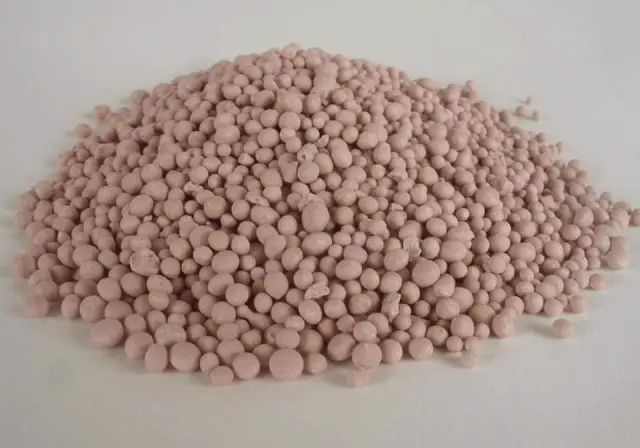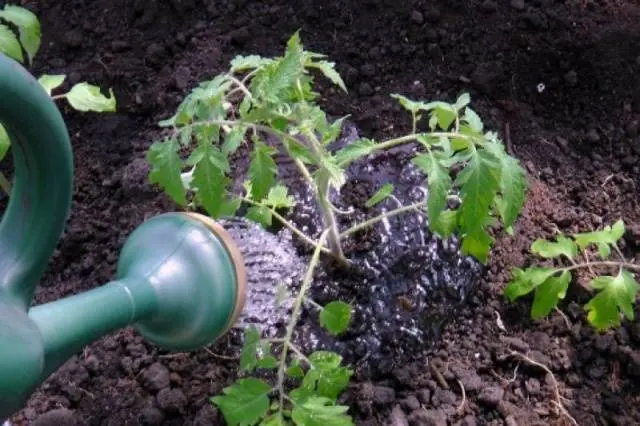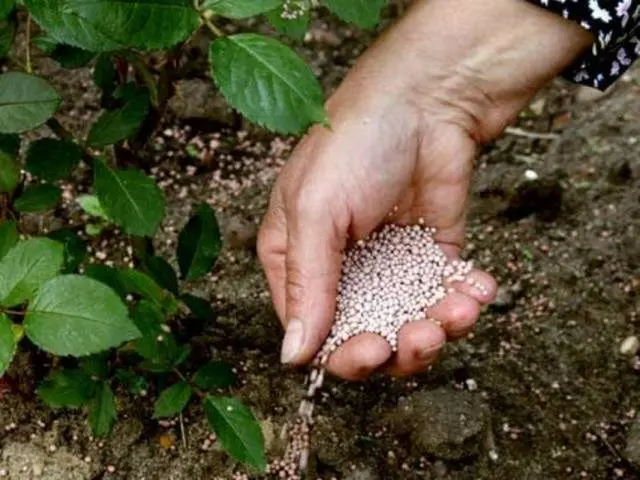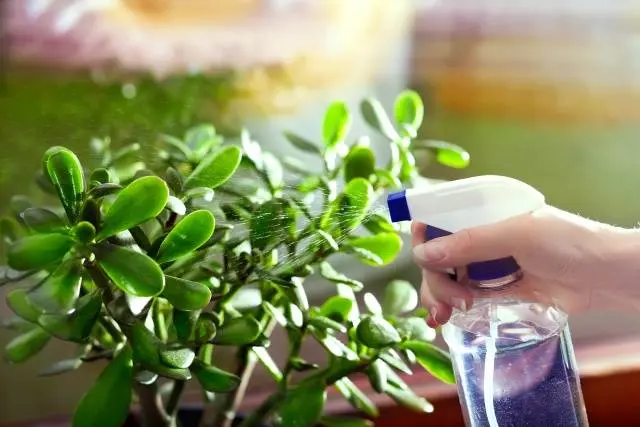Contents
Minerals are necessary for plants for active growth and fruiting. Especially effective are complex fertilizers, which include elements vital for plants. One of them is nitroammofoska, suitable for feeding any kind of crops.
Fertilizer composition
The composition of nitroammophoska includes three main components: nitrogen (N), phosphorus (P) and potassium (K). The NPK complex directly affects the growth and fruiting of horticultural crops.
The fertilizer consists of small granules of a gray-pink flower, highly soluble in water. Hue varies depending on the batch and manufacturer.
Nitrogen contributes to the formation of green mass in plants, the passage of photosynthesis and metabolism. With a lack of nitrogen, the growth of crops slows down, which affects their appearance. As a result, the growing season is shortened and yields are reduced.
During the development period, plantings need phosphorus. The trace element is involved in cell division and the growth of the root system. With a lack of phosphorus, the color and shape of the leaves change, the roots die off.
Potassium affects yield, fruit taste and plant immunity. Its deficiency reduces the resistance of plants to diseases and pests. Such top dressing is especially important during the period of active growth. Potassium is applied in autumn to increase the winter hardiness of shrubs and trees.
In nitroammophosk, forms are presented that are easily absorbed by plants. Phosphorus is available in three compounds, they begin to act actively after use. The main compound is monocalcium phosphate, which dissolves in water and does not accumulate in the soil.

Advantages and disadvantages
Nitroammophoska is an effective fertilizer that is beneficial when used correctly. When using a substance, you need to consider its pros and cons.
Advantages of nitroammophoska:
- high concentration of useful minerals;
- the presence of a complex of substances necessary for the development of crops;
- good solubility in water;
- home storage;
- preservation of structure and color within the expiration date.
- increase in productivity up to 70%;
- a variety of ways to use;
- affordable price.
The main disadvantages are:
- is of artificial origin;
- short shelf life (no more than 6 months from the date of manufacture);
- prolonged use leads to the accumulation of nitrates in the soil and plants;
- the need to comply with the rules of storage due to flammability and explosion hazard.
Varieties and analogues
Depending on the concentration of active substances, several types of nitroammophoska are distinguished. They are used on different types of soil.
The most common is the 16:16:16 fertilizer. The content of each of the main components is 16%, the total amount of useful substances is more than 50%. Fertilizer is universal and suitable for any soil. Sometimes the designation 1:1:1 is used, which indicates an equal ratio of the main substances.
On soils with a deficiency of phosphorus and potassium, a composition of 8:24:24 is used. Their final content reaches 40% or more. Top dressing is effective for root crops, winter crops, potatoes, suitable for regions with frequent rains. It is applied to the soil after harvesting cereals and legumes.

If the soils are rich in phosphorus, then nitroammophoska is used in the composition of 21: 0,1: 21 or 17: 0,1: 28. On other types of soil, it is used before planting rapeseed, fodder crops, sugar beet, sunflower.
Manufacturers produce nitroammophoska, the composition of which takes into account the characteristics of a particular region. In the Voronezh region, fertilizers are sold at 15:15:20 and 13:13:24. The local soil contains little potassium, and such top dressing provides high yields.
Nitroammophoska has analogues similar in composition:
- Azofoska. In addition to the main three elements, it contains sulfur. It has a similar effect on plants.
- Ammophoska. The fertilizer is enriched with sulfur and magnesium. Suitable for cultivation of crops in closed ground.
- Nitrophoska. In addition to the main complex, it includes magnesium. Contains forms of nitrogen that are quickly washed out of the soil.
- Nitroammophos. Does not contain potassium, which limits the scope of its application.
How to use
The use of nitroammophoska fertilizer is possible before planting crops or during their growing season. The best results are obtained on chernozem soils with high moisture levels.
If the soil is dense in structure, then the penetration of nutrients is slower. Chernozem and heavy clay soil is best fertilized in the fall. In light soil, fertilizer is applied in the spring.
Plants are treated at any stage. The last top dressing is carried out 3 weeks before harvest. Application rates depend on the type of crop.
Tomatoes
After treatment with nitroammophos, the immunity of tomatoes is strengthened, their growth and fruiting are accelerated. Fertilizer is combined with other substances containing potassium and phosphorus: superphosphate, potassium sulfate.
The procedure for subcorking tomatoes includes several stages:
- 2 weeks after transplanting to a greenhouse or open area;
- one month after the first treatment;
- when forming bonds.

For the first feeding prepare a solution consisting of 1 tbsp. l. substances in a large bucket of water. 0,5 l is poured under the bush.
The next treatment is prepared in combination with organic matter. A bucket of water with a volume of 10 liters requires a tablespoon of fertilizer and 0,5 kg of bird droppings.
For the third top dressing, in addition to nitroammophoska, add 1 tbsp. l. sodium humate. The resulting product is applied under the root of the plants.
cucumbers
The use of nitroammophoska fertilizer for cucumbers increases the number of ovaries and the duration of fruiting. Feeding cucumbers includes two stages:
- introduction into the soil before planting the crop;
- watering until the ovaries appear.
For 1 sq. m soil requires 30 g of the substance. To form ovaries, cucumbers are watered with a solution consisting of 1 tbsp. l. fertilizer for 5 liters of water. The norm of funds for each bush is 0,5 liters.
Potatoes
Nitroammophoska is used when planting potatoes. 1 tsp is placed in each well. substance that is mixed with soil. Top dressing accelerates the formation and growth of roots.
Planted potatoes are watered with a solution. For 20 liters of water add 2 tbsp. l. substances.
Peppers and aubergines
Nightshade crops are fed in the spring. 3 weeks after planting in the ground, a nutrient solution is prepared, consisting of 40 g of fertilizer in a large bucket of water.
Top dressing stimulates the fruiting of peppers and eggplants, improves the taste and quality of fruits. Processing is carried out in the morning or in the evening.
Berry and fruit crops
Nitroammophoska is used for basal feeding of fruit-bearing shrubs and trees. The rules of use are defined as follows:
- 400 g for apple, pear, plum and other fruit trees;
- 50 g for raspberries;
- 70 g for gooseberry and currant bushes;
- 30 g for strawberries.

Substance close up in the landing hole. During the season, shrubs and trees are sprayed with a solution. For 10 liters of water, nitroammophoska is added in an amount of 10 g.
The vineyard is also treated with a nutrient solution along the leaf. The concentration of the substance is 2 tbsp. l. to a large bucket of water.
Flowers and indoor plants
In the spring, the flower garden is fed a couple of weeks after the sprouts appear. The fertilizer is suitable for annuals and perennials. For 10 liters of water, 30 g is enough.
When buds are formed, a more concentrated solution is prepared, including 50 g of fertilizer. Additional processing is carried out during the flowering period.
Top dressing for garden roses is especially effective. It is better to feed roses in spring and autumn, and during the season it is enough to spray with a solution.
Houseplants are sprayed with a solution consisting of 20 g of fertilizer per 5 liters of water. Processing promotes flowering.
Safety measures
Nitroammophoska belongs to the 3rd safety class. If the rules of use and storage are violated, the substance harms humans, plants and the environment.
Rules for the use of nitroammophoska:
- Do not overheat the fertilizer. Store it in a room with a temperature below +30°C. Do not leave the substance near a heater, stove or other heat sources.
- Monitor the humidity level in the storage area. The maximum value is 50%.
- Do not leave nitroammophoska near substances that are easily flammable (wood, paper). It is best to store it in a building made of brick or other refractory material.
- Do not store the substance next to other fertilizers to prevent the occurrence of a chemical reaction.
- Transport fertilizer by ground transport in compliance with the temperature regime.
- Use before the expiration date.
- Dose according to accepted standards.
- Use gloves, do not allow fertilizer to get on the mucous membranes, skin, respiratory tract. If you experience an allergic reaction or poisoning, consult a doctor.
- After applying nitroammofosk fertilizer in the garden, keep it out of the reach of children and pets.

Conclusion
Nitroammophoska is a complex fertilizer, the use of which has a positive effect on plants. The substance is introduced in accordance with the norms. Subject to the rules of storage and use, the fertilizer does not harm humans and the environment.









